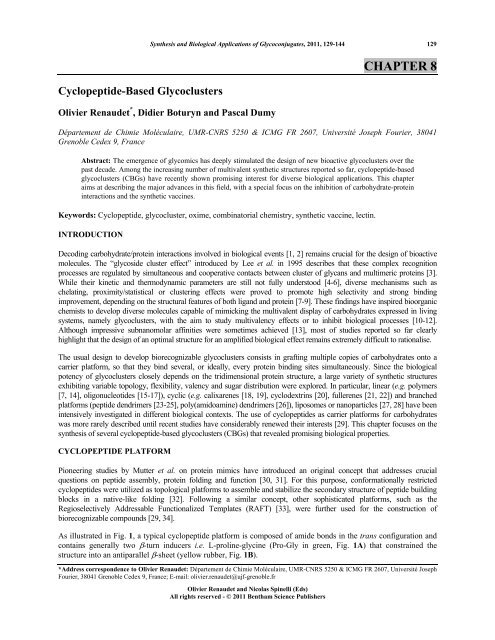chapter 2 - Bentham Science
chapter 2 - Bentham Science
chapter 2 - Bentham Science
Create successful ePaper yourself
Turn your PDF publications into a flip-book with our unique Google optimized e-Paper software.
Cyclopeptide-Based Glycoclusters<br />
Synthesis and Biological Applications of Glycoconjugates, 2011, 129-144 129<br />
Olivier Renaudet * , Didier Boturyn and Pascal Dumy<br />
Olivier Renaudet and Nicolas Spinelli (Eds)<br />
All rights reserved - © 2011 <strong>Bentham</strong> <strong>Science</strong> Publishers<br />
CHAPTER 8<br />
Département de Chimie Moléculaire, UMR-CNRS 5250 & ICMG FR 2607, Université Joseph Fourier, 38041<br />
Grenoble Cedex 9, France<br />
Abstract: The emergence of glycomics has deeply stimulated the design of new bioactive glycoclusters over the<br />
past decade. Among the increasing number of multivalent synthetic structures reported so far, cyclopeptide-based<br />
glycoclusters (CBGs) have recently shown promising interest for diverse biological applications. This <strong>chapter</strong><br />
aims at describing the major advances in this field, with a special focus on the inhibition of carbohydrate-protein<br />
interactions and the synthetic vaccines.<br />
Keywords: Cyclopeptide, glycocluster, oxime, combinatorial chemistry, synthetic vaccine, lectin.<br />
INTRODUCTION<br />
Decoding carbohydrate/protein interactions involved in biological events [1, 2] remains crucial for the design of bioactive<br />
molecules. The “glycoside cluster effect” introduced by Lee et al. in 1995 describes that these complex recognition<br />
processes are regulated by simultaneous and cooperative contacts between cluster of glycans and multimeric proteins [3].<br />
While their kinetic and thermodynamic parameters are still not fully understood [4-6], diverse mechanisms such as<br />
chelating, proximity/statistical or clustering effects were proved to promote high selectivity and strong binding<br />
improvement, depending on the structural features of both ligand and protein [7-9]. These findings have inspired bioorganic<br />
chemists to develop diverse molecules capable of mimicking the multivalent display of carbohydrates expressed in living<br />
systems, namely glycoclusters, with the aim to study multivalency effects or to inhibit biological processes [10-12].<br />
Although impressive subnanomolar affinities were sometimes achieved [13], most of studies reported so far clearly<br />
highlight that the design of an optimal structure for an amplified biological effect remains extremely difficult to rationalise.<br />
The usual design to develop biorecognizable glycoclusters consists in grafting multiple copies of carbohydrates onto a<br />
carrier platform, so that they bind several, or ideally, every protein binding sites simultaneously. Since the biological<br />
potency of glycoclusters closely depends on the tridimensional protein structure, a large variety of synthetic structures<br />
exhibiting variable topology, flexibility, valency and sugar distribution were explored. In particular, linear (e.g. polymers<br />
[7, 14], oligonucleotides [15-17]), cyclic (e.g. calixarenes [18, 19], cyclodextrins [20], fullerenes [21, 22]) and branched<br />
platforms (peptide dendrimers [23-25], poly(amidoamine) dendrimers [26]), liposomes or nanoparticles [27, 28] have been<br />
intensively investigated in different biological contexts. The use of cyclopeptides as carrier platforms for carbohydrates<br />
was more rarely described until recent studies have considerably renewed their interests [29]. This <strong>chapter</strong> focuses on the<br />
synthesis of several cyclopeptide-based glycoclusters (CBGs) that revealed promising biological properties.<br />
CYCLOPEPTIDE PLATFORM<br />
Pioneering studies by Mutter et al. on protein mimics have introduced an original concept that addresses crucial<br />
questions on peptide assembly, protein folding and function [30, 31]. For this purpose, conformationally restricted<br />
cyclopeptides were utilized as topological platforms to assemble and stabilize the secondary structure of peptide building<br />
blocks in a native-like folding [32]. Following a similar concept, other sophisticated platforms, such as the<br />
Regioselectively Addressable Functionalized Templates (RAFT) [33], were further used for the construction of<br />
biorecognizable compounds [29, 34].<br />
As illustrated in Fig. 1, a typical cyclopeptide platform is composed of amide bonds in the trans configuration and<br />
contains generally two -turn inducers i.e. L-proline-glycine (Pro-Gly in green, Fig. 1A) that constrained the<br />
structure into an antiparallel -sheet (yellow rubber, Fig. 1B).<br />
*Address correspondence to Olivier Renaudet: Département de Chimie Moléculaire, UMR-CNRS 5250 & ICMG FR 2607, Université Joseph<br />
Fourier, 38041 Grenoble Cedex 9, France; E-mail: olivier.renaudet@ujf-grenoble.fr

















